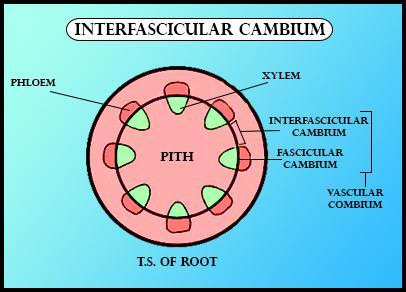
Interfascicular cambium develops from the cell of
(a) Medullary rays
(b) Xylem parenchyma
(c) Endodermis
(d) Pericycle
Answer
474.9k+ views
Hint: They are cellular structures found in some species of wood. They seem like radial planar structures, perpendicular to the growth rings, which are visible to the eye. During a transverse section, they seem as radiating lines from the centre of the log. In an axial section, they'll appear as a spread of transverse markings.
Complete answer:
Interfascicular cambium mature from the cells of medullary rays. The cambium present between the primary xylem and first phloem is named as Intrafascicular cambium. At the time of secondary growth, cells of medullary rays, during a line with Intrafascicular cambium become meristematic and form interfascicular cambium. Therefore, the Interfascicular and Intrafascicular cambiums constitute an endless ring that divides the primary xylem and primary phloem and is understood as a cambium ring. These medullary or pith rays are important for the radial transportation of the water, minerals, and other organic substances. They transport the substances from the centre to the periphery. These rays also are referred to as vascular rays or pith rays. Xylem parenchyma is a component of complex tissue called “Xylem”. Parenchyma cells of xylem are mainly involved within the storage of carbohydrate, fats and water conduction. The Pericycle may be a cylinder of parenchyma or sclerenchyma cells that lies just inside the endodermis and is the outermost part of the stele of plants. It is involved in lateral root initiation and development also as in secondary root growth. Intrinsically it contributes to formation of the basis system and provides rise to 2 secondary meristems in roots: vascular cambium and cork cambium. The endodermis (the innermost layer of the cortex adjacent to the Pericycle) consists of closely packed cells that have within their walls Casparian strips, water-impermeable deposits of suberin that regulate water and mineral uptake by the roots.

So, the correct answer is ‘Medullary rays’.
Note: Vascular cambia are present in dicots and gymnosperms but not monocots (which usually lack secondary growth). A couple of leaf types even have a vascular cambium. In dicot and gymnosperm trees, the vascular cambium is the obvious line separating the bark and wood; they even have a cork cambium.
Complete answer:
Interfascicular cambium mature from the cells of medullary rays. The cambium present between the primary xylem and first phloem is named as Intrafascicular cambium. At the time of secondary growth, cells of medullary rays, during a line with Intrafascicular cambium become meristematic and form interfascicular cambium. Therefore, the Interfascicular and Intrafascicular cambiums constitute an endless ring that divides the primary xylem and primary phloem and is understood as a cambium ring. These medullary or pith rays are important for the radial transportation of the water, minerals, and other organic substances. They transport the substances from the centre to the periphery. These rays also are referred to as vascular rays or pith rays. Xylem parenchyma is a component of complex tissue called “Xylem”. Parenchyma cells of xylem are mainly involved within the storage of carbohydrate, fats and water conduction. The Pericycle may be a cylinder of parenchyma or sclerenchyma cells that lies just inside the endodermis and is the outermost part of the stele of plants. It is involved in lateral root initiation and development also as in secondary root growth. Intrinsically it contributes to formation of the basis system and provides rise to 2 secondary meristems in roots: vascular cambium and cork cambium. The endodermis (the innermost layer of the cortex adjacent to the Pericycle) consists of closely packed cells that have within their walls Casparian strips, water-impermeable deposits of suberin that regulate water and mineral uptake by the roots.

So, the correct answer is ‘Medullary rays’.
Note: Vascular cambia are present in dicots and gymnosperms but not monocots (which usually lack secondary growth). A couple of leaf types even have a vascular cambium. In dicot and gymnosperm trees, the vascular cambium is the obvious line separating the bark and wood; they even have a cork cambium.
Recently Updated Pages
Class 11 Question and Answer - Your Ultimate Solutions Guide

Master Class 11 English: Engaging Questions & Answers for Success

Master Class 11 Computer Science: Engaging Questions & Answers for Success

Master Class 11 Maths: Engaging Questions & Answers for Success

Master Class 11 Social Science: Engaging Questions & Answers for Success

Master Class 11 Economics: Engaging Questions & Answers for Success

Trending doubts
10 examples of friction in our daily life

What problem did Carter face when he reached the mummy class 11 english CBSE

Difference Between Prokaryotic Cells and Eukaryotic Cells

State and prove Bernoullis theorem class 11 physics CBSE

What organs are located on the left side of your body class 11 biology CBSE

Proton was discovered by A Thomson B Rutherford C Chadwick class 11 chemistry CBSE




